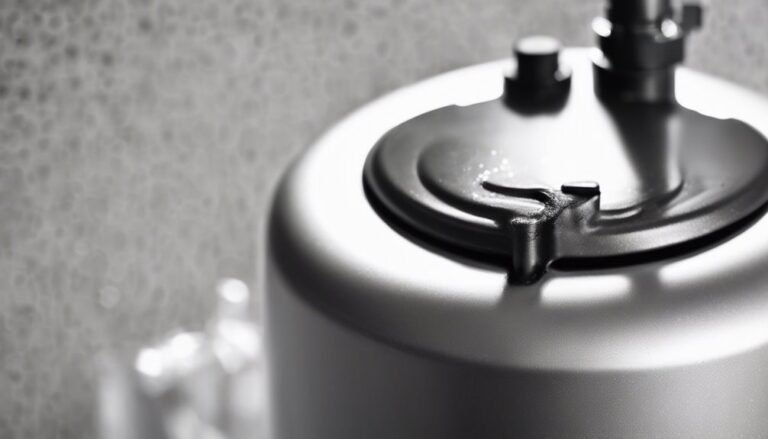How to Hook up Water Softner?
Installing a water softener can feel like an intimidating task, yet it's a straightforward process that can greatly improve your home's water quality. You'll want to start by choosing the right location and gathering the necessary tools to guarantee a smooth setup. As you begin connecting the system, understanding flow direction and drainage becomes essential. What's often overlooked is how these initial steps can affect your water's hardness level in the long run, prompting questions about maintenance and adjustments you might need to take into account.
Key Takeaways
- Choose a suitable location near the main water supply with adequate space and access to drainage and power outlets.
- Turn off the main water supply and drain the pipes before making any connections to prevent leaks.
- Use an adjustable wrench and pipe cutter to connect the water softener to the plumbing, ensuring correct flow direction.
- Install the bypass valve correctly and test for leaks by turning the water supply back on.
- Adjust the settings based on water hardness tests and schedule regular maintenance for optimal performance.
Understanding Water Softener Types
When choosing a water softener, it's crucial to understand the different types available to find the best fit for your needs. The most common type is the ion exchange water softener. This system works by replacing hard minerals like calcium and magnesium with sodium ions, effectively reducing water hardness.
It's reliable and efficient, making it a popular choice for households.
You'll also encounter different salt types used in these systems. The traditional option is rock salt, which is inexpensive but can leave impurities in your softener. If you're looking for higher purity, consider evaporated salt, which dissolves easily and minimizes buildup.
There's also solar salt, made from evaporated seawater, offering a middle ground regarding cost and purity.
As you evaluate your options, think about your water's hardness level and your budget. Knowing these factors will guide you in selecting the most suitable water softener type for your home.
Tools and Materials Needed
Before you start hooking up your water softener, you'll need to gather some essential tools and materials.
This includes everything from wrenches and tubing to safety equipment that'll keep you protected during the installation.
Let's take a closer look at what you'll need to make this process smooth and safe.
Essential Tools Required
To successfully hook up a water softener, you'll need a few essential tools and materials on hand. Proper tool selection is vital for guaranteeing a smooth installation process, so gather these items before you start:
- Adjustable Wrench: This will help you tighten or loosen plumbing connections.
- Phillips and Flathead Screwdrivers: These are necessary for securing any components and making adjustments.
- Pipe Cutter: If you need to modify existing pipes, a pipe cutter will provide a clean cut.
- Teflon Tape: This is used to seal threaded connections, preventing leaks.
- Bucket: Keep a bucket handy to catch any water that may spill during installation.
These tools won't only make the process easier but also help avoid common pitfalls.
When following installation tips, verify you have everything organized and ready to go. This preparation will save you time and frustration.
Necessary Materials Overview
Gathering the necessary materials is vital for a successful water softener installation. You'll need a few key components to guarantee everything runs smoothly and efficiently.
Start with the water softener unit itself, which you'll choose based on your water quality and system benefits. Don't forget the brine tank, as it's essential for the regeneration process.
Next, gather your plumbing supplies, including PVC pipes, fittings, and hoses, to connect the system to your existing water line. You'll also need a wrench, pliers, and a screwdriver to secure the connections.
If your water softener requires electrical power, make sure you have a power outlet nearby and any necessary electrical supplies.
Additionally, consider purchasing water testing kits to assess your water quality before and after installation. This way, you can see firsthand how the system benefits your home.
Finally, have a bucket or container ready for any water runoff during the setup process. By assembling these materials ahead of time, you'll make the installation process smoother and more efficient, allowing you to enjoy the advantages of softened water sooner.
Safety Equipment Checklist
Ensuring safety during your water softener installation is essential for a hassle-free experience. Before you begin, take the time to gather the necessary safety gear and materials. This won't only help protect you but also keep you aware of potential hazards while working.
Here's a checklist of items you should have on hand:
- Safety goggles
- Gloves
- Dust mask
- Knee pads
- First aid kit
Wearing safety gear like goggles and gloves can prevent injuries from sharp tools or chemicals. A dust mask can help you avoid inhaling any harmful dust or particles, especially if you're working in tight spaces.
Hazard awareness is vital; always be mindful of your surroundings and any potential risks, such as slipping or tripping.
Preparing Your Installation Site
Before diving into the installation process, you'll want to properly prepare your site for the water softener. Start by choosing an appropriate location, preferably near your main water supply line. Make sure that the area is clean and free of obstacles, as this makes installation easier and safer.
Next, consider the space requirements for your water softener. Most units need at least a few feet of clearance on all sides for maintenance and operation. Measure the dimensions of the unit and verify you have enough room to accommodate it.
Furthermore, keep in mind that the water softener will require access to a power outlet, so plan accordingly.
It's also a good idea to assess the floor's condition. If you're installing in a basement or utility room, make sure the floor can support the weight of the system once it's filled with salt and water.
Finally, check for nearby drainage options. You'll need a place to drain excess water, so having a nearby floor drain or sink can simplify the process. By taking these steps for site preparation, you'll set yourself up for a smoother installation experience.
Connecting the Water Softener
Now that you've prepared your installation site, it's time to connect your water softener.
You'll need a few essential tools to get started, along with a step-by-step approach to guarantee everything fits together perfectly.
Let's also go over some common installation mistakes to help you avoid pitfalls and make the process smoother.
Necessary Tools Required
To successfully connect your water softener, you'll need a few essential tools on hand.
Having the right equipment not only streamlines the process but also makes it safer and more efficient.
Remember, proper tool maintenance is vital to guarantee they last through multiple installations.
Here's a quick list of what you'll need:
- Adjustable Wrench: For tightening and loosening plumbing fittings.
- Pipe Cutter: To make clean cuts on pipes for a secure fit.
- Teflon Tape: For sealing threaded connections and preventing leaks.
- Screwdriver Set: To secure brackets and other components.
- Buckets: To catch any water that may spill during the installation.
Step-by-Step Instructions
You've successfully connected your water softener, ensuring your home enjoys better water quality.
Common Installation Mistakes
Even though installing a water softener can greatly improve your home's water quality, several common mistakes can undermine its effectiveness.
To guarantee you avoid these common pitfalls, pay close attention during the installation process.
Here are some troubleshooting tips to help you stay on track:
- Incorrect flow direction: Always check that the water flows into the correct inlet and outlet ports.
- Poor drainage setup: Confirm the brine tank has proper drainage to avoid overflow issues.
- Bypassing the softener: Don't forget to adjust the bypass valve; otherwise, untreated water may still flow through your system.
- Neglecting maintenance: After installation, remember to regularly check and refill the salt in the brine tank.
- Ignoring water pressure: Make sure your home's water pressure is within the recommended range to avoid damaging the unit.
Setting Up the Bypass Valve
Setting up the bypass valve is an important step in making sure your water softener operates effectively. This valve allows you to bypass the softener when needed, such as during maintenance or if you want to use hard water temporarily.
Start with the bypass valve installation by locating it, usually found on the inlet and outlet sides of your system.
Next, check the valve position. You'll typically find three settings: service, bypass, and refill. For normal operation, make sure it's in the service position. If it's not, you can easily adjust it by turning the knob or lever.
Use valve adjustment techniques—like gently twisting or pulling—to make sure it moves smoothly and locks into place without any resistance.
It's vital to double-check that all connections are secure once you've completed the installation. A properly set bypass valve not only protects your softener but also assures that you have access to hard water when necessary.
Testing and Adjusting Settings
Once the bypass valve is properly set, it's time to test and adjust the settings on your water softener for ideal performance. This step is essential for guaranteeing you get the best water quality and efficiency from your system.
Start by checking the hardness level of your water with a testing kit. Knowing the hardness level helps you determine how much salt and regeneration time you'll need.
Here are some adjustment techniques you can use:
- Set the hardness level: Adjust it according to the test results.
- Adjust the salt dosage: Confirm it aligns with your water's hardness.
- Regeneration cycle timing: Set it for off-peak hours to save on water and salt.
- Check the brine tank: Make certain it has enough salt for efficient operation.
- Monitor water usage: Keep track of how much water you use to adjust settings over time.
After making these adjustments, run some water through the system and check for changes in water quality.
If you notice improvements, you're on the right track! Regular testing and adjustments keep your water softener running smoothly.
Maintaining Your Water Softener
Maintaining your water softener is essential for ensuring its longevity and ideal performance. To keep your system running smoothly, you need to create a regular maintenance schedule. This schedule should include checking the salt levels in the brine tank at least once a month. If it's low, refill it with high-quality salt designed for water softeners.
Next, monitor your water quality every few months. If you notice any changes, like increased hardness or scaling, it might be time to adjust your settings or perform a manual regeneration.
Also, inspect the system for any leaks or clogs, which can disrupt its efficiency.
Another key aspect is cleaning the resin beads inside the tank. This process can help remove any buildup that may affect performance. You should do this annually or as needed, depending on your water quality.
Lastly, don't forget to check the filters, if your system has them. Replacing or cleaning them according to the manufacturer's guidelines can greatly enhance your softener's effectiveness.
Frequently Asked Questions
Can I Install a Water Softener Myself, or Should I Hire a Professional?
You can tackle the installation yourself for a DIY project, but consider professional help if you're unsure about plumbing. Weigh your skills and comfort level before deciding which route suits you best.
How Long Does the Water Softener Installation Process Typically Take?
The installation duration for a water softener usually ranges from a few hours to a full day, depending on the installation complexity. If you're handy, you might finish it quicker than expected!
What Are the Signs That My Water Softener Needs Maintenance?
You'll notice signs your water softener needs maintenance when you see changes in water quality, like scale buildup or soap not lathering. Regularly check your system and follow maintenance tips to guarantee peak performance.
Are There Any Safety Precautions I Should Take During Installation?
Did you know that nearly 30% of home accidents occur during DIY projects? When installing, wear safety gear, and make certain your electrical connections are secure to prevent shocks or fires. Stay safe and enjoy your project!
How Often Should I Replace the Salt in My Water Softener?
You should check the salt levels monthly and refill as needed. Depending on the salt types and your water usage, maintaining a regular maintenance schedule guarantees your water softener operates efficiently and prolongs its lifespan.
Conclusion
To sum up, hooking up a water softener can greatly improve your home's water quality and protect your plumbing and appliances. Imagine a family in a hard water area; after installing their softener, they noticed softer skin, cleaner dishes, and even longer-lasting laundry. By following the steps outlined, you can enjoy similar benefits. Remember, regular maintenance is key to ensuring your system operates efficiently for years to come, giving you peace of mind and better water every day.







